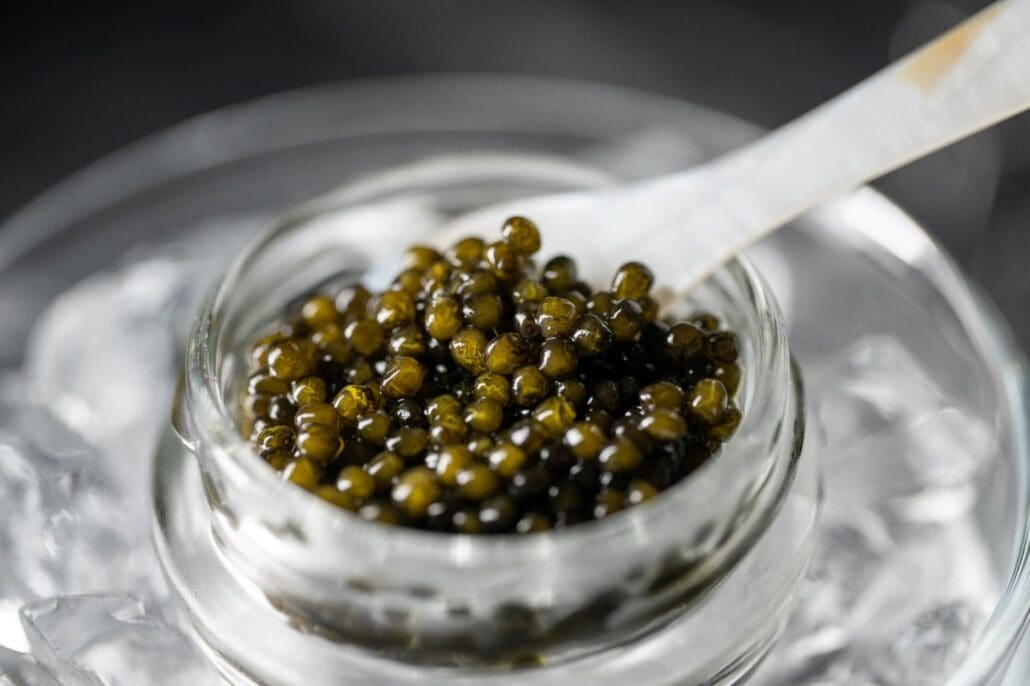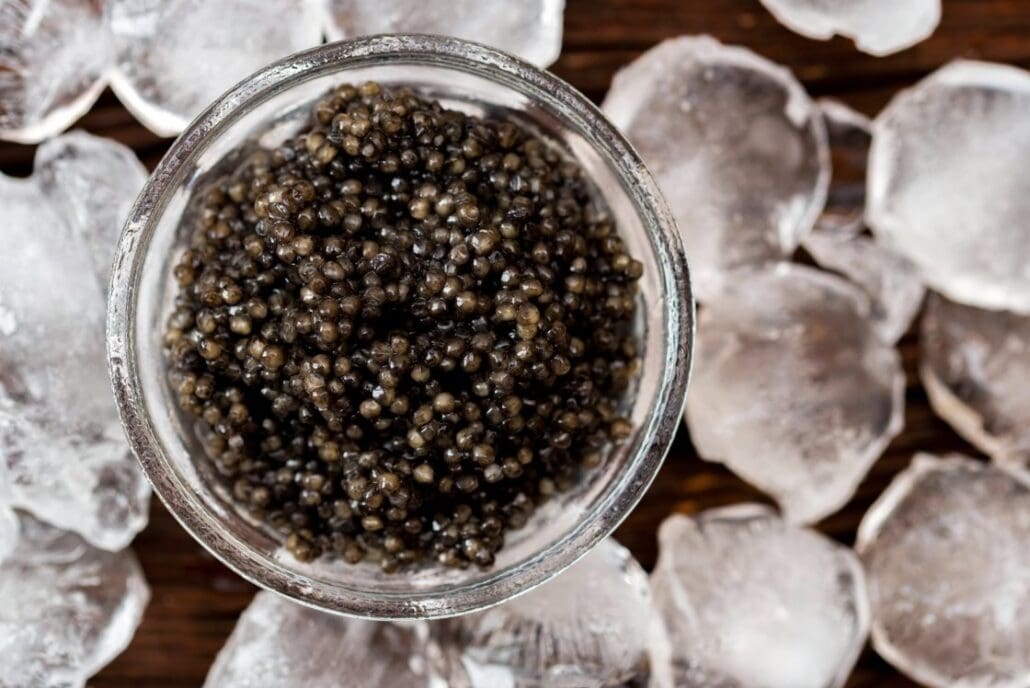Why Is Caviar So Expensive: The Factors Behind Its Cost
Caviar is a rare delicacy that’s viewed as the pinnacle of culinary decadence, so it’s no surprise that it fetches a steep price all over the world. It’s a luxury item that’s closely associated with lavish lifestyles and extravagant celebrations.
To those unfamiliar with the history of caviar, the exorbitant cost can be somewhat of a mystery. It’s easy to assume that caviar is expensive merely because of its distinguished reputation, but there are very legitimate reasons for the high price tags.
There’s no denying that caviar is expensive, but understanding the factors that drive its value skyward can be quite illuminating for the uninitiated.
Let’s dive in!
Roe vs. Caviar
Before we explore the cost of caviar, it’s important that we differentiate between caviar and other fish roe. Not all fish roe is pricey, so you might be wondering what makes caviar so special.
- Roe: Refers to the eggs of any fish, such as Salmon roe or Trout roe. While it’s very common for roe to be called caviar, the word caviar actually has a stricter definition.
- Caviar: Refers to roe that comes specifically from Sturgeon species.
So, when we talk about why caviar is expensive, we’re exclusively discussing Sturgeon roe—true caviar. With that said, some of the following reasons for the high cost of caviar do apply to other fish roes, too.
1. Low Wild Sturgeon Populations Have Restrictions on Fishing
Scarcity naturally pushes the price of desirable items up. When there are limited quantities of something, and a large group wishes to own it, an unofficial bidding war is the inevitable conclusion.
Sturgeon eggs are rare. Just like other luxury items—from precious metals and gemstones to saffron and aged whiskeys—caviar’s price is heavily derived from its relative unavailability.
Sturgeon populations have diminished for a number of reasons, including overfishing, pollution, and habitat loss. Fewer Sturgeons mean fewer Sturgeon eggs. Caviar is expensive because every glistening pearl is an elusive treasure that happens to be edible.
Because Sturgeon are rare (some species are even endangered), wild caviar harvesting practices are strictly regulated, further adding to their scarcity.
2. Expensive and Time-Consuming Farming
Farm-raised caviar is more widely available, but aquaculture farming can be challenging and costly. It requires specialized equipment to replicate the natural environments of Sturgeon species. These fish need large ponds or tanks with well-oxygenated water and specific feeding habits. The expenses associated with raising Sturgeon, including veterinary care, feed, and water purification, can be significant.
Beyond the financial side, Sturgeon farming is also a major time investment compared to other fish species. Depending on the type of Sturgeon, it can take 8 to 10 years for the fish to reach maturity and start producing roe.
Why is caviar expensive? Simply put, it costs a lot for the consumer because it costs a lot to produce. Farmers invest significant amounts of money and many years before a fish becomes profitable. It’s a risky endeavor, and a return on investment isn’t guaranteed.
3. Difficult and Delicate Harvesting and Processing
Once a Sturgeon finally starts producing eggs, the hard work is just beginning. Caviar farming and harvesting are very delicate processes that require a great deal of skill, knowledge, and experience.
First, the farmer must harvest the roe at just the right time or the quality of the batch will suffer. Extracting the eggs must be performed with the utmost care or the roe could get damaged. This significant risk is another reason for caviar’s expensive price.
Once the caviar is successfully extracted, it must be carefully rinsed of impurities and cured, which involves salting the roe for both flavor and preservation—a delicate balance that demands exceptional expertise, finesse, and care.
Unfortunately, sturgeons must be harvested to remove their caviar eggs. Current experimentation is focused on developing techniques to extract the eggs without harming the fish. Techniques such as cesarean section surgery are expected to be viable alternatives in the future.
4. Rigid Quality Standards

In order for caviar producers to consistently offer premium products, they often use expensive equipment and, in some cases, traditional techniques that have been passed down from generation to generation. However, even that rigorous approach isn’t always enough.
After the caviar is finally harvested and cured, experts inspect and grade it based on flavor, color, texture, and size. Batches that don’t meet stringent standards are either discarded or sold for a lower price.
Why is caviar expensive? This exhaustive approach ensures the highest level of quality and preserves the elite reputation of true caviar, but it also cuts into profits, further driving the price up. You pay for exceptional quality.
There’s an incredible amount of specialized labor, skill, and artisanry that goes into each and every batch before the caviar even hits the tin. As the end consumer, you’re not just paying for the caviar itself—you’re paying for the staggering amount of work that went into it.
5. Ethical and Environmental Factors
Caviar would be less expensive if unscrupulous producers didn’t keep their operations ethically and environmentally responsible.
Caviar is expensive because it costs a lot of money to minimize harm to natural habitats when sourcing wild caviar and, similarly, to provide farm-raised Sturgeon with humane living conditions.
Furthermore, many caviar farms take significant steps to keep Sturgeon harvesting sustainable. They often participate in habitat restoration projects and preservation programs. Many also join in educational campaigns to spread awareness.
6. Regional Challenges
Caviar has traditionally been sourced from regions near the Caspian Sea, such as Iran and Russia. However, environmental and political complications have made it difficult to source caviar from some prominent caviar-producing areas.
Why is caviar expensive? Importing caviar from the major regions can be difficult, and added expenses like taxes, tariffs, import duties, and shipping fees further increase the cost.
Additionally, some caviar-producing regions are extremely exclusive and secretive. They carefully safeguard their sources and methods, ensuring that only a small handful of producers and sellers are able to offer caviar from that region.
7. The Farm-to-Table Journey

Once the caviar is packaged and ready to ship, there are still more expenses on the horizon. During shipping, the caviar must be kept at a very specific temperature to keep it fresh and flavorful. Caviar is expensive because it requires special cold packaging and rapid shipping.
Savor the Difference
As you can see, caviar’s price isn’t only derived from its esteemed reputation! Fortunately, when you shop at our family-owned and operated caviar store, you can enjoy the best of both worlds—top-quality caviar at highly competitive prices.
We source our sustainable caviars directly from the producers, which helps keep our prices down. And, because we pack every batch to order, you can enjoy some of the world’s freshest American caviar and imported caviar the way they were meant to be experienced.
Why is caviar expensive? Well, if it didn’t have a premium price, it wouldn’t be a premium product in the first place! You’re paying for a rare and coveted delicacy—and everything that happens behind the scenes before it finally reaches your caviar bowl.
We’re confident that once you experience the difference, you’ll find that high-quality caviar is absolutely worth every penny. Indulge in our exquisite caviar collections today!



